Flexural Behavior of Tightly Spliced Concrete Composite Slabs with Diagonal Reinforcement
Abstract
1. Introduction
2. Experiment Design
2.1. Specimen Design
2.2. Loading Scheme
2.3. Measurement Parameters and Point Layout
3. Experimental Results and Analysis
3.1. Failure Modes and Crack Propagation Process
3.2. Load-Deflection Curve
- (1)
- For all specimens, a linear relationship between load and midspan deflection was observed prior to cracking. Upon crack initiation, a distinct inflection appeared in the load–deflection curve, accompanied by a reduction in slope, indicating a progressive decrease in specimen stiffness. For both the monolithic Cast-in-Place Slab (XJB) and composite slabs PFB1–PFB4, once the yield point was reached, the rate of increase in midspan deflection significantly exceeded that of the applied load. This behavior resulted in a pronounced flattening of the curves, characteristic of a ductile structural response under continued loading.
- (2)
- PFB2 and PFB4 exhibited load-deflection curves essentially similar to the cast-in-place slab (XJB), with their bending stiffness also closely approximating that of the XJB slab. This demonstrates that the two new types of tightly spliced joints can significantly enhance the flexural stiffness of composite slabs, enabling the tightly spliced composite slabs to achieve mechanical performance comparable to cast-in-place slabs.
- (3)
- The slope of the curves for thicker plates in both the elastic and elastoplastic stages was greater than that for thinner plates, signifying a significant increase in stiffness with increasing plate thickness. When the specimen thickness increased from 150 mm to 200 mm, the cracking load of Tightly Spliced Slab I increased by 90%, the yield load by 79%, and the ultimate load by 65%. Similarly, for Tightly Spliced Slab II, the cracking load increased by 125%, the yield load by 79%, and the ultimate load by 69%. Therefore, plate thickness is a key parameter influencing the flexural performance of composite slabs. In practical engineering applications, plate thickness should be reasonably selected to achieve an optimal balance between safety and economy.
- (4)
- The loads corresponding to each characteristic point and bending stiffness of PFB1 were slightly higher than those of PFB3, although the difference was not significant. The same trend was observed for PFB2 and PFB4. This indicates that the addition of a horizontal bent segment at the end of the inclined reinforcement in the base slab of Tightly Spliced Slab I, intended to improve anchorage performance, did not significantly enhance the bearing capacity of the composite slab. Even with a slab thickness of 150 mm, the straight inclined reinforcement in Tightly Spliced Slab II met the required anchorage performance.
- (5)
- The cracking load of the Standardized Tightly Spliced Slab PFB5 was significantly lower than that of the Cast-in-Place Slab (XJB), PFB2, and PFB4. This finding indicates that the flexural performance of the standardized tightly spliced slab is inadequate when only additional rebar is provided at the joints. Furthermore, the inability to prevent tearing at the composite interface caused the additional rebar to detach from the surrounding concrete, preventing full utilization of its tensile capacity and resulting in brittle failure.
3.3. Steel Reinforcement Strain
3.4. Analysis of Bearing Capacity at the Seam Section of Composite Slabs
4. Finite Element Analysis
4.1. Material Constitutive
4.2. Finite Element Model
4.3. Verification of Finite Element Results
5. Parameter Analysis
5.1. Strength of Composite Concrete Layer
5.2. Height of the Prefabricated Base Slab Ribs
5.3. Stirrup Location with Respect to the Joint
6. Conclusions
- (1)
- The Bent Diagonal-Reinforced Tightly Spliced Slab (Tightly Spliced Slab I) and Ribbed Diagonal-Reinforced Tightly Spliced Slab (Tightly Spliced Slab II), along with their respective joint detailing measures, effectively mitigate uplift and slippage at the composite interface. During loading, vertical flexural-tensile cracks develop primarily at the slab edges, with no horizontal cracking observed, indicating a ductile failure mode.
- (2)
- The load–deflection responses of Tightly Spliced Slab I closely resemble those of Tightly Spliced Slab II, demonstrating that both novel dense joint types provide excellent force-transfer performance and superior structural integrity.
- (3)
- Under ultimate load conditions, the additional rebars at the joints of both slab types reached the material yield strain. Proper joint detailing and effective shear resistance measures at the composite interface ensured a reliable force-transfer path between the additional rebars and the base slab reinforcement.
- (4)
- The flexural capacity of both the Bent Diagonal-Reinforced Tightly Spliced Slab (Tightly Spliced Slab I) and the Ribbed Diagonal-Reinforced Tightly Spliced Slab (Tightly Spliced Slab II) can be calculated using the method specified in the Code for Design of Concrete Structures (GB 50010-2010) [18]. The measured flexural capacity is slightly higher than the calculated value, achieving the design objective of the equivalent cast-in-place section capacity while remaining on the conservative side for safety.
- (5)
- Finite element simulation of the Ribbed Diagonal-Reinforced Tightly Spliced Slab (Tightly Spliced Slab II) indicates that while ensuring safety and economic efficiency, it is recommended that the concrete strength of the composite layer in the Ribbed Diagonal-Reinforced Tightly Spliced Slab should not exceed C40, the rib height of the base slab should be set at 20 mm, and the stirrups should be placed within 200 mm on either side of the joint.
- (6)
- As a preliminary investigation into the two types of diagonally reinforced tightly spliced composite slabs, this study involved a limited number of test specimens and primarily focused on short-term static performance. Future research could further expand the range of specimen parameters and consider the influence of practical conditions such as long-term loading and fatigue performance to more comprehensively assess their engineering applicability. Nevertheless, the structural configurations and design recommendations proposed in this paper provide a valuable reference for promoting the application of such slabs in engineering practice.
Author Contributions
Funding
Data Availability Statement
Conflicts of Interest
References
- Du, Y.Z. Current Status and Future Strategies for Building Industrialization in China. Highway 2021, 66, 284–288. (In Chinese) [Google Scholar]
- Yan, X.C. Research Status and Deficiencies of Concrete Prefabricated Composite Slabs. China Facil. Facil. 2023, 139–141. (In Chinese) [Google Scholar]
- Feng, X.; Chen, M.; Tian, Z.C. Summary of classification and research on concrete composite slab. Build. Struct. 2024, 54, 138–144. (In Chinese) [Google Scholar]
- Zhao, F. Analysis on the Performance and Benefit of Composite Slab for Prefabricated Building. Eng. Technol. Res. 2024, 9, 110–112. (In Chinese) [Google Scholar]
- JGJ 1-2014; Technical Specification for Precast Concrete Structures. China Architecture & Building Press: Beijing, China, 2014. (In Chinese)
- Han, S.; Jeong, J.; Joo, H.; Choi, S.H.; Choi, S.; Kim, K.S. Flexuraland Shear Performance of Prestressed Composite Slabs with Inverted Multi-Ribs. Appl. Sci. 2019, 9, 4946. [Google Scholar] [CrossRef]
- Liu, J.; Hu, H.; Li, J.; Chen, Y.F.; Zhang, L. Flexural behavior of prestressed concrete composite slab with precast inverted T-shaped ribbed panels. Eng. Struct. 2020, 215, 110687. [Google Scholar] [CrossRef]
- Li, M.; Zhou, Z.; Wu, Q.; Yan, W.; Yuan, S. Analysis of the Mechanical Properties of a Bidirectional Laminated Slab with Shear Keys. Coatings 2022, 12, 1542. [Google Scholar] [CrossRef]
- He, Q.F.; Hu, C.Q.; Yang, K.H.; Yi, W.J. Experimental Study on Joint Structure and Mechanical Performance of Densely Assembled Composite Slabs. J. Hunan Univ. (Nat. Sci. Ed.) 2022, 49, 111–122. (In Chinese) [Google Scholar]
- He, Q.; Wu, Y.; Hu, C.; Yang, K.; Yi, W. Experimental Study of the Two-WayMechanical Behavior of Tightly Spliced Prestressed Reinforced Concrete Laminated Slab. J. Struct. Eng. 2025, 151, 04025063. [Google Scholar] [CrossRef]
- Zhang, J.; Chen, J.; Ye, X.; Qiu, X.; Deng, L.; Su, Y. Experimental Study on Flexural Behavior of the Composite Bottom Slab of theStiffened Steel Truss. J. Phys. Conf. Ser. 2023, 2519, 012030. [Google Scholar] [CrossRef]
- Xiao, Y.; Li, X. Experimental study on bending performance of concrete composite slabs using new connection joints without extended bars. Build. Struct. 2023, 53, 83–89. (In Chinese) [Google Scholar]
- Yang, Y.; Jiang, X.W.; Nie, X.; Wang, S.H.; Wu, B. Experimental study on mechanical behavior of concrete composite slab with rabbets. J. Build. Struct. 2023, 44, 142–151. (In Chinese) [Google Scholar]
- Lin, Y.; Ni, H.R.; Zhao, Z.J.; Zhou, X.J. Study on flexural behavior of steel pipetruss concrete composite slabs with rabbets. China Civ. Eng. J. 2025, 58, 38–49. (In Chinese) [Google Scholar]
- Chen, X.; Luo, B.; Liu, X. Experimental and Numerical Investigation of a New Type of Composite Slab with a Separate Joint. Buildings 2024, 14, 1890. [Google Scholar] [CrossRef]
- Fayed, S.; Madenci, E.; Özkiliç, O.Y.; Basha, A. The flexural behaviour of multi-layered steel fiber reinforced orultra-high performance-normal concrete composite ground slabs. J. Build. Eng. 2024, 95, 109901. [Google Scholar] [CrossRef]
- Guan, X.; Cheng, H.J.; Qin, Q.; Shi, H.J.; Tang, L.Y.; Cheng, L.; Ren, X.; Zhang, C.H.; Gao, Z.G. Experiment on Flexural Behavior of Closely Jointed Composite Slabs Connectedon Vertical Bolts. J. Xi’an Univ. Sci. Technol. 2025, 45, 340–350. (In Chinese) [Google Scholar]
- GB 50010-2010; Code for Design of Concrete Structures. China Architecture & Building Press: Beijing, China, 2011. (In Chinese)
- T/CECS 993-2022; Technical Specification for Prestressed Concrete Composite Slab Connecting Without Gap. China Architecture & Building Press: Beijing, China, 2022. (In Chinese)
- GB/T 50152-2012; Standard for Test Method of Concrete Structures. China Architecture & Building Press: Beijing, China, 2012. (In Chinese)
- Wu, Q.; Hu, H.S.; Chen, Y.H. Influence of Stiffened Storey on Economy and Carbon Emission of Frame-Core Tube Structures. J. Huaqiao Univ. (Nat. Sci. Ed.) 2023, 44, 460–468. [Google Scholar]

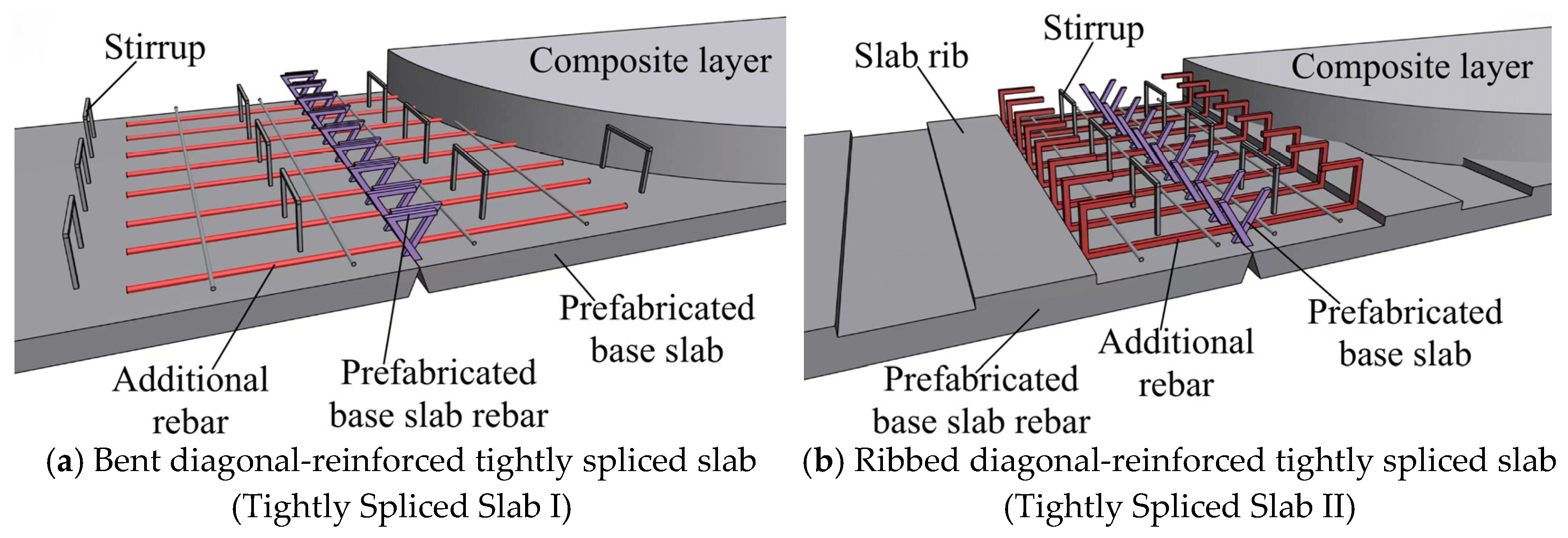



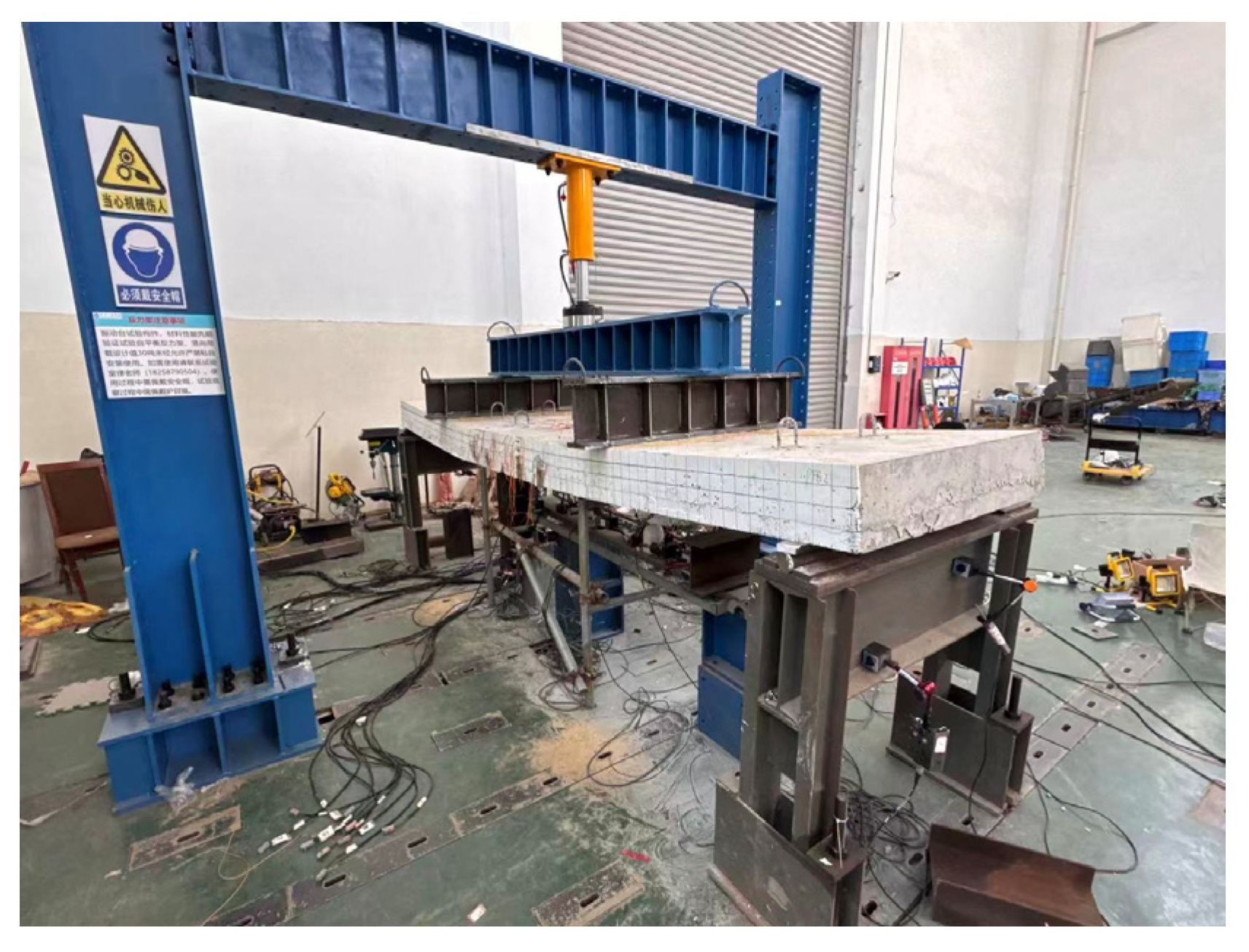
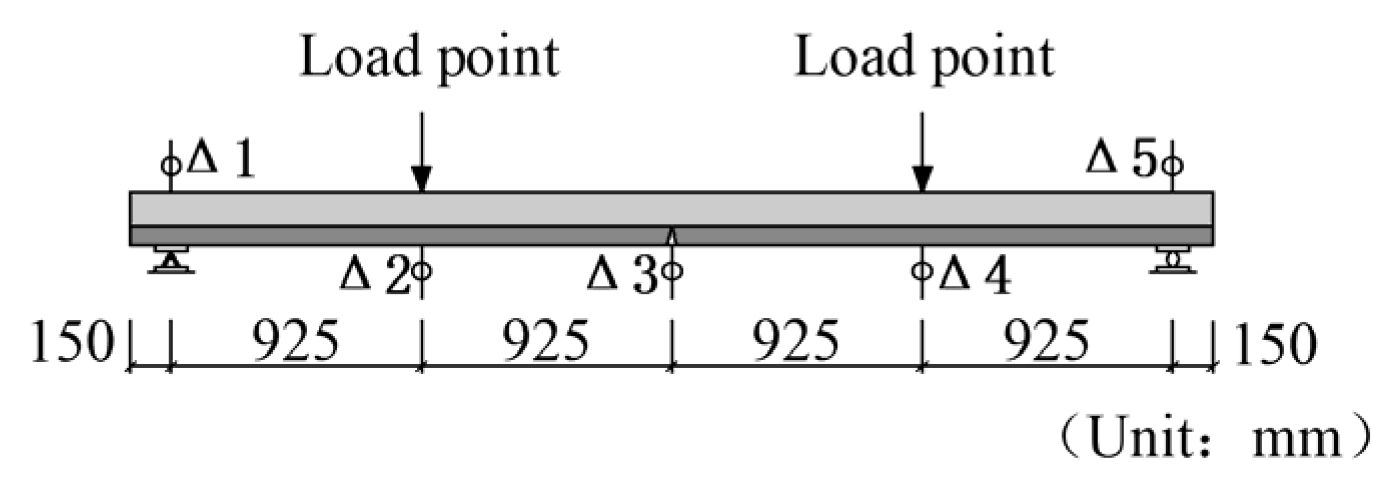
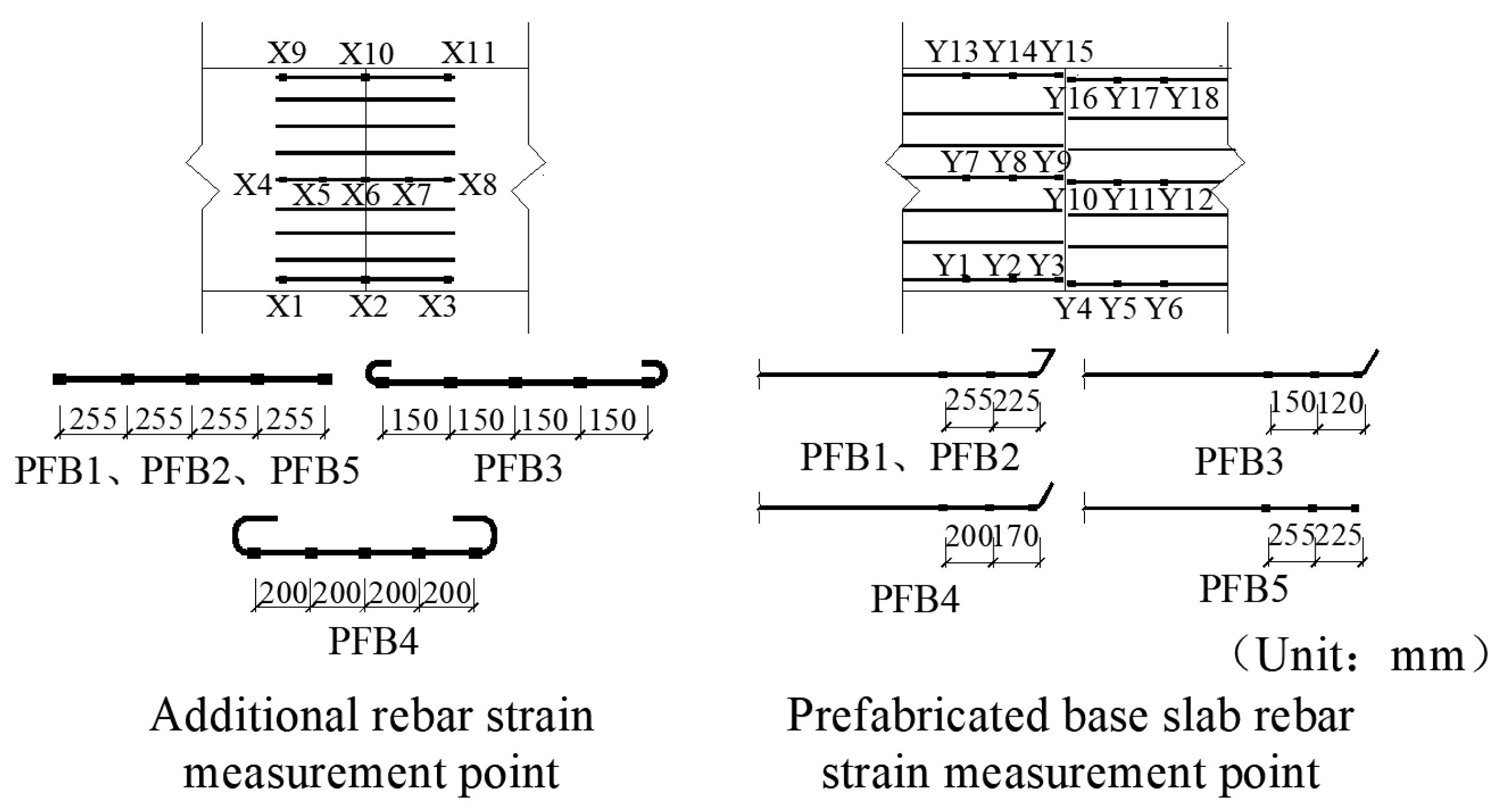
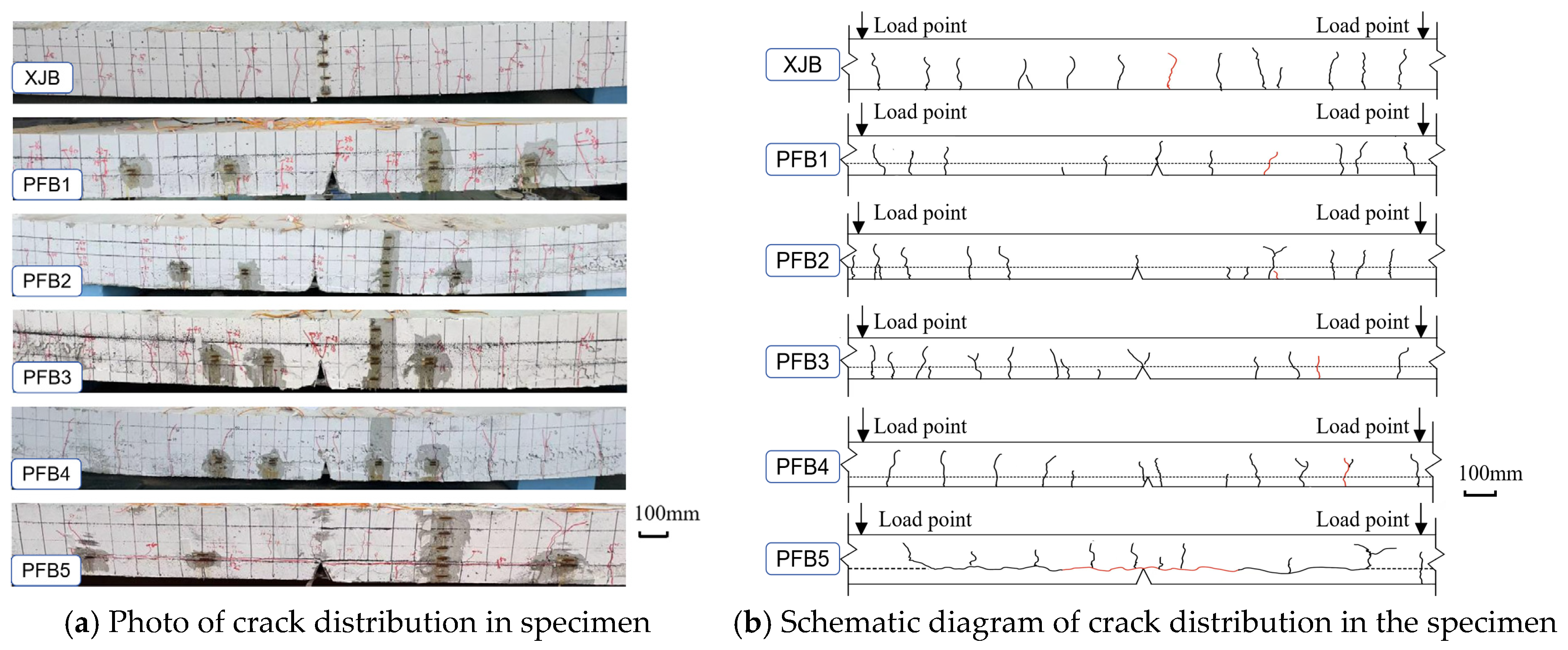

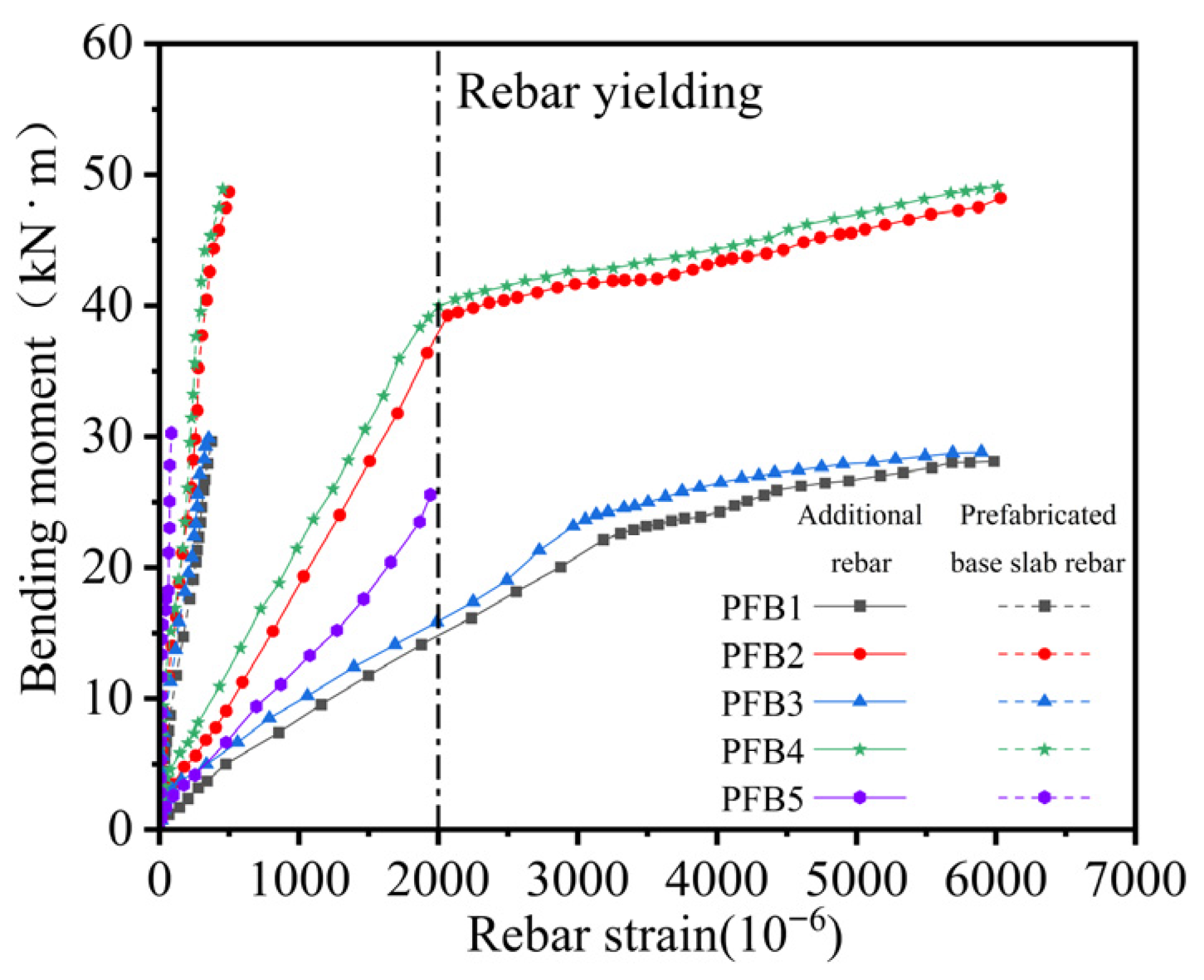
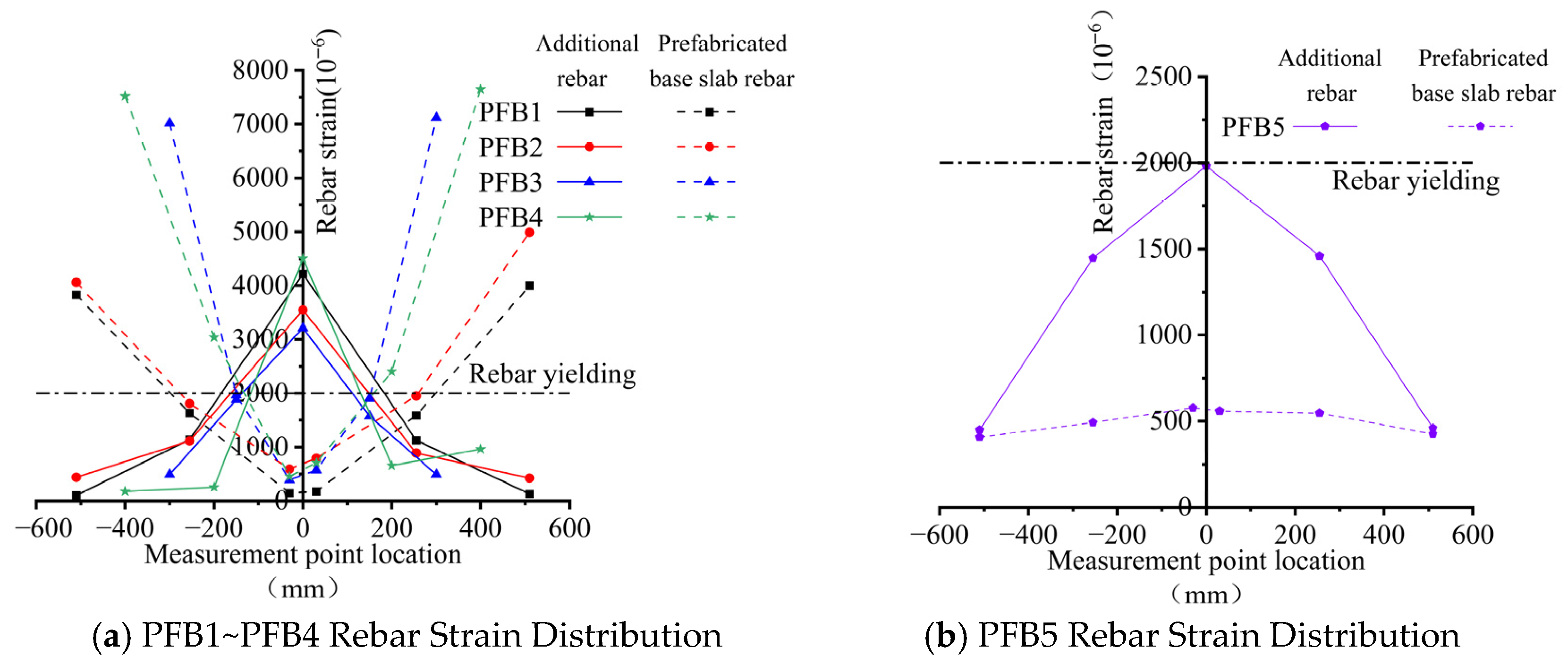

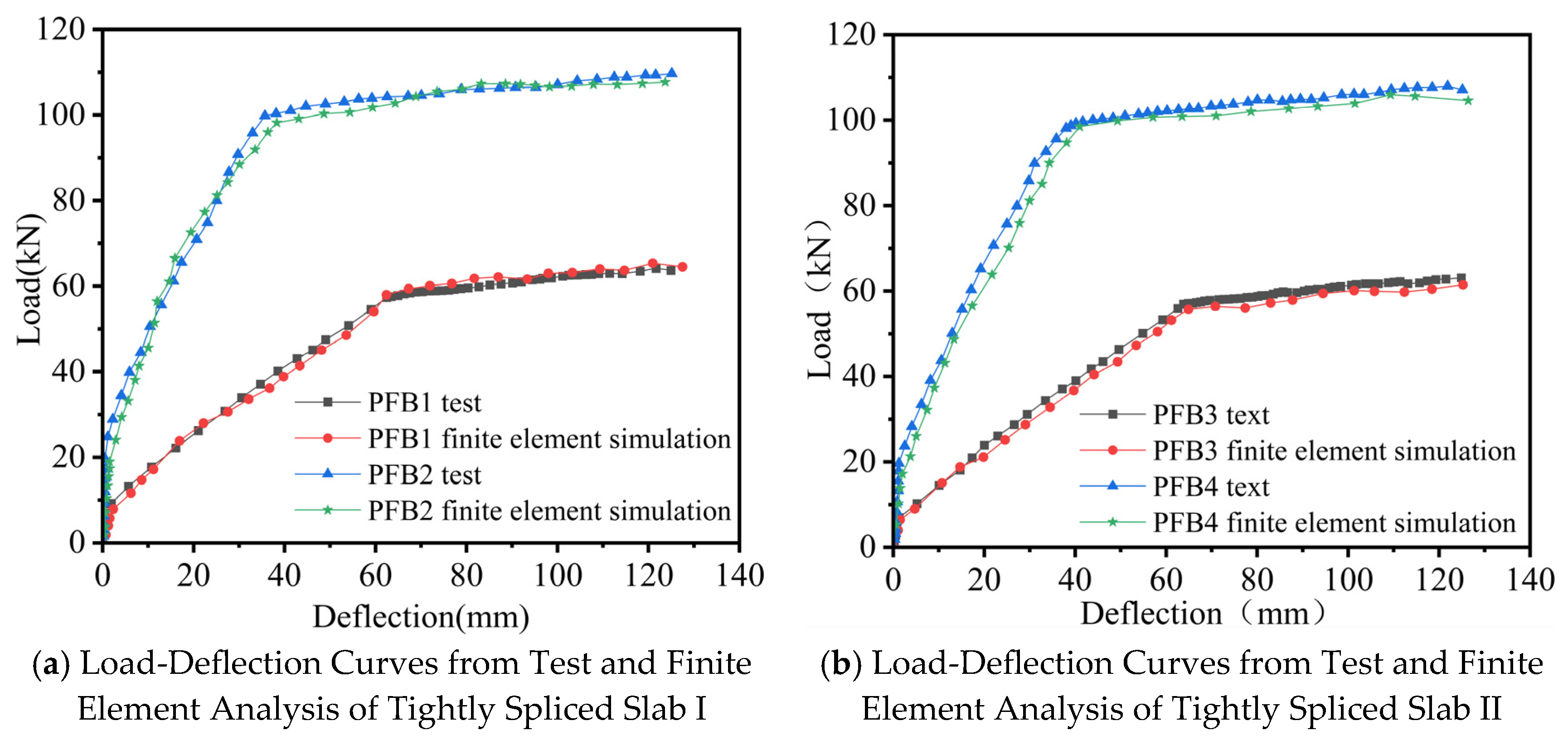
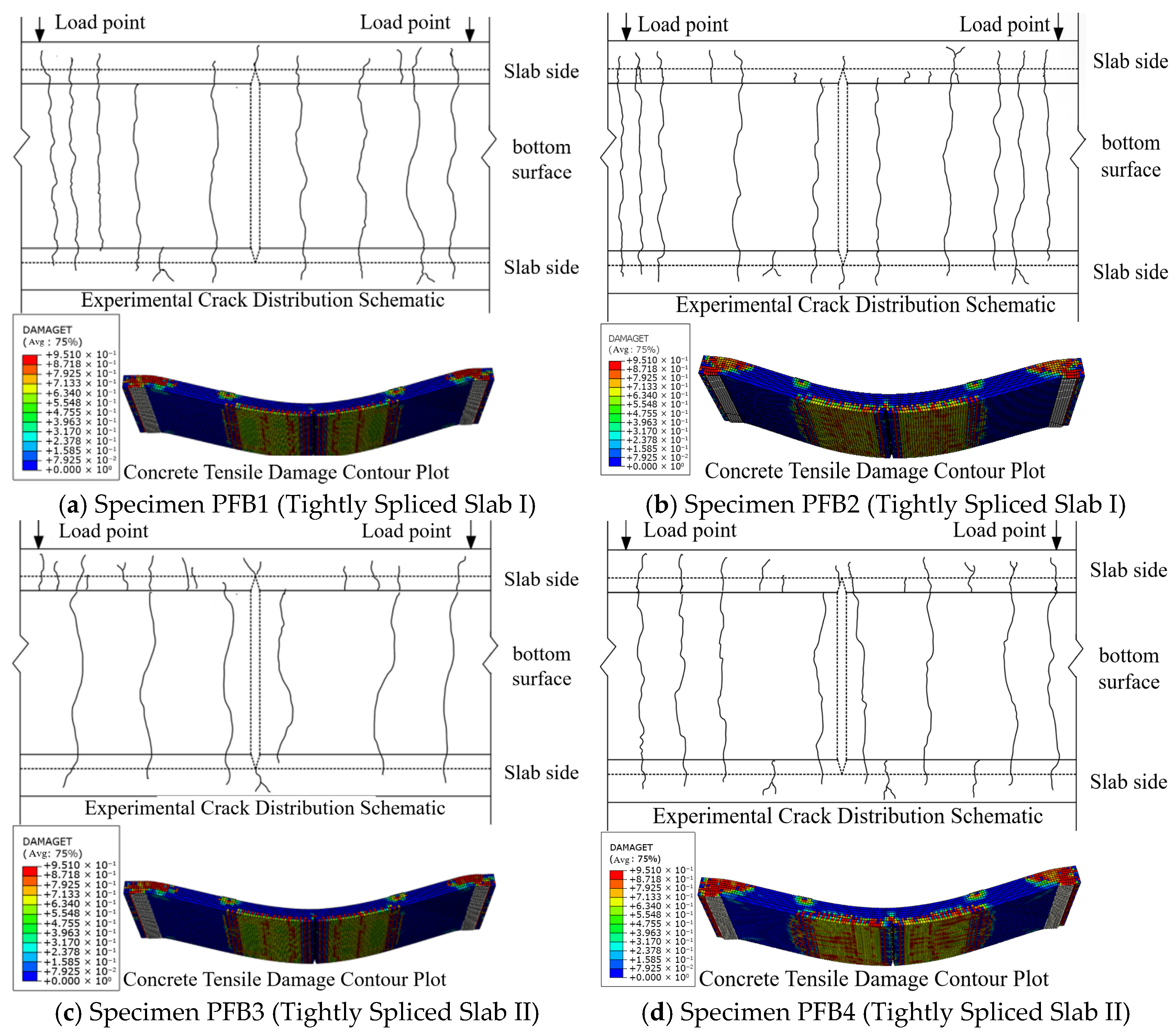

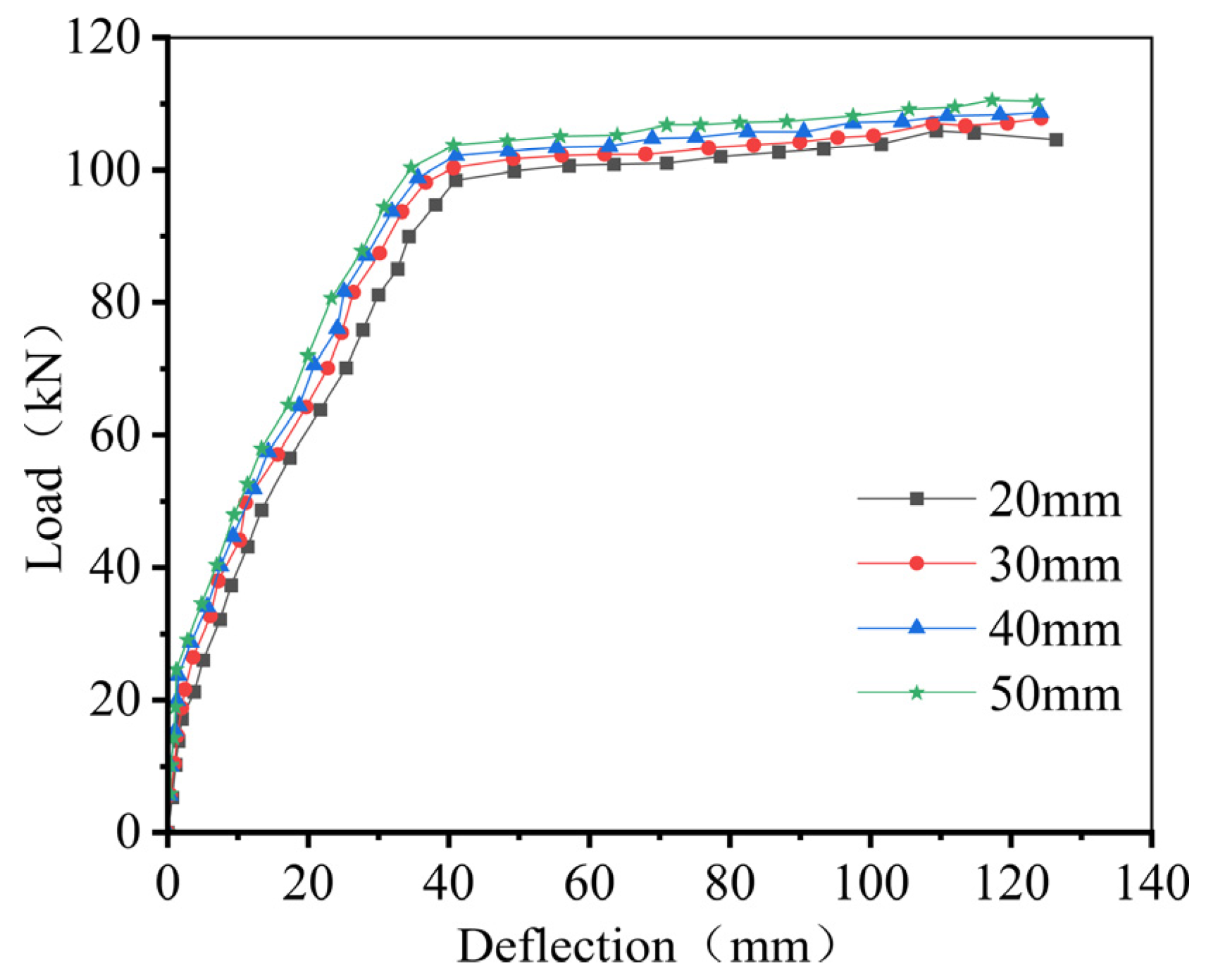
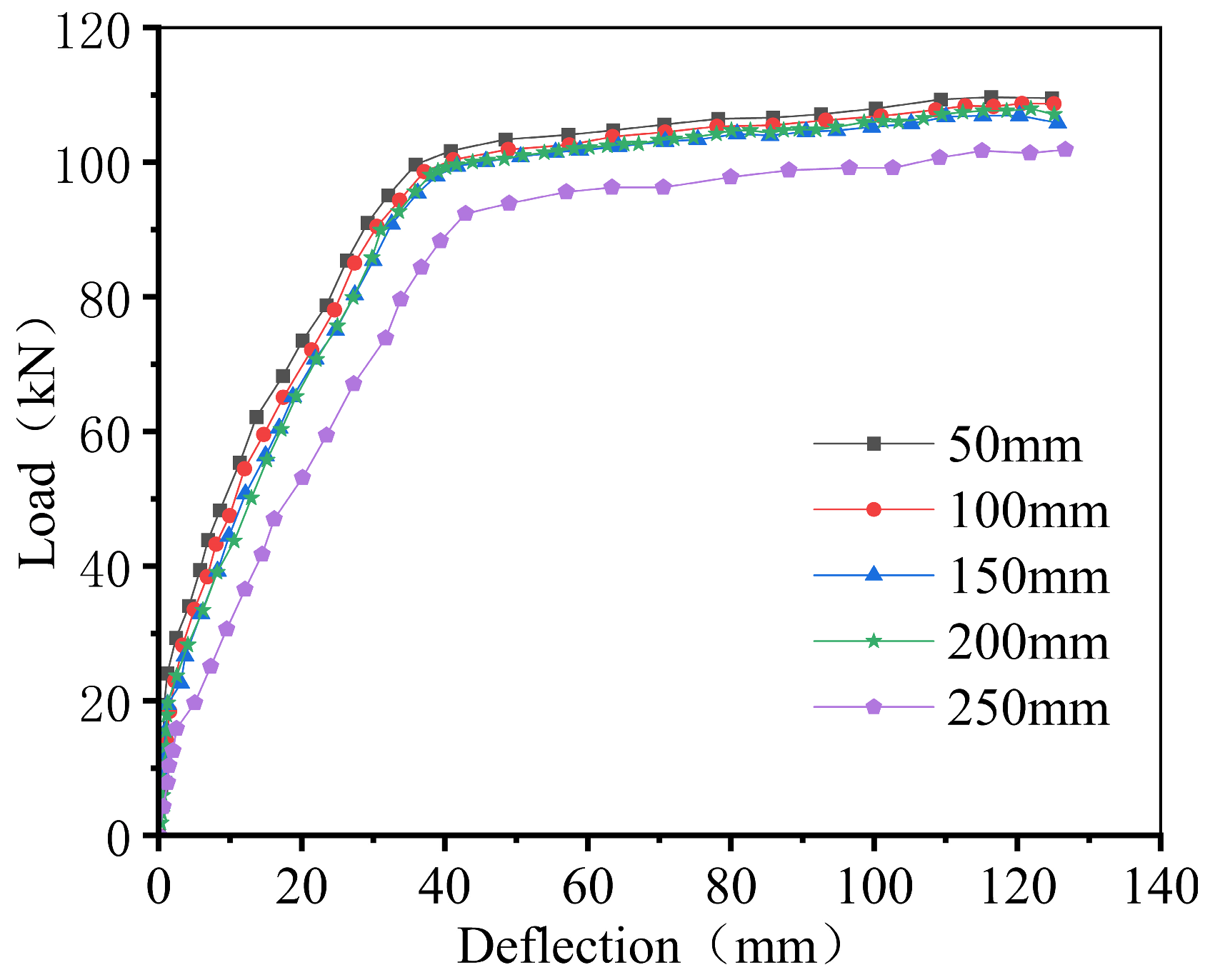
| Concrete | Tested Compressive Strength (MPa) | Average (MPa) | ||
|---|---|---|---|---|
| Test Cube 1 | Test Cube 2 | Test Cube 3 | ||
| Composite layer | 31.34 | 31.65 | 32.40 | 31.80 |
| Prefabricated base slab | 34.85 | 36.68 | 34.55 | 35.00 |
| Specimen Number | Specimen Type | h (mm) | h1 (mm) | Prefabricated Base Slab Flexural Rebar | Prefabricated Base Slab Rib | Additional Rebar | ||
|---|---|---|---|---|---|---|---|---|
| Height (mm) | Width (mm) | Spacing (mm) | ||||||
| XJB | Cast-in-place slab | 200 | —— | Ø10@120 | —— | —— | —— | —— |
| PFB1 | Tightly spliced slab I | 150 | 90 | Ø10@150 | —— | —— | —— | Ø12@120 |
| PFB2 | Tightly spliced slab I | 200 | 140 | Ø10@120 | —— | —— | —— | Ø12@120 |
| PFB3 | Tightly spliced slab II | 150 | 90 | Ø10@150 | 20 | 200 | 200 | Ø12@120 |
| PFB4 | Tightly spliced slab II | 200 | 140 | Ø10@120 | 20 | 200 | 200 | Ø12@120 |
| PFB5 | Standard Tightly spliced slab | 200 | 140 | Ø10@120 | —— | —— | —— | Ø12@120 |
| Specimen | XJB | PFB1 | PFB2 | PFB3 | PFB4 | PFB5 |
|---|---|---|---|---|---|---|
| Bending stiffness () | ||||||
| Cracking point (kN) | 20 | 10 | 19 | 8 | 18 | 2 |
| Yield point (kN) | 98 | 53 | 95 | 52 | 93 | - |
| Ultimate point (kN) | 110 | 66 | 109 | 64 | 108 | - |
| Specimen | |||
|---|---|---|---|
| PFB1 | 30.52 | 28.10 | 1.09 |
| PFB2 | 50.88 | 46.94 | 1.08 |
| PFB3 | 30.28 | 28.10 | 1.08 |
| PFB4 | 50.53 | 46.94 | 1.08 |
Disclaimer/Publisher’s Note: The statements, opinions and data contained in all publications are solely those of the individual author(s) and contributor(s) and not of MDPI and/or the editor(s). MDPI and/or the editor(s) disclaim responsibility for any injury to people or property resulting from any ideas, methods, instructions or products referred to in the content. |
© 2025 by the authors. Licensee MDPI, Basel, Switzerland. This article is an open access article distributed under the terms and conditions of the Creative Commons Attribution (CC BY) license (https://creativecommons.org/licenses/by/4.0/).
Share and Cite
Zhang, Z.; Cai, K.; Yin, J. Flexural Behavior of Tightly Spliced Concrete Composite Slabs with Diagonal Reinforcement. Materials 2025, 18, 4919. https://doi.org/10.3390/ma18214919
Zhang Z, Cai K, Yin J. Flexural Behavior of Tightly Spliced Concrete Composite Slabs with Diagonal Reinforcement. Materials. 2025; 18(21):4919. https://doi.org/10.3390/ma18214919
Chicago/Turabian StyleZhang, Zechao, Kejian Cai, and Jiang Yin. 2025. "Flexural Behavior of Tightly Spliced Concrete Composite Slabs with Diagonal Reinforcement" Materials 18, no. 21: 4919. https://doi.org/10.3390/ma18214919
APA StyleZhang, Z., Cai, K., & Yin, J. (2025). Flexural Behavior of Tightly Spliced Concrete Composite Slabs with Diagonal Reinforcement. Materials, 18(21), 4919. https://doi.org/10.3390/ma18214919






